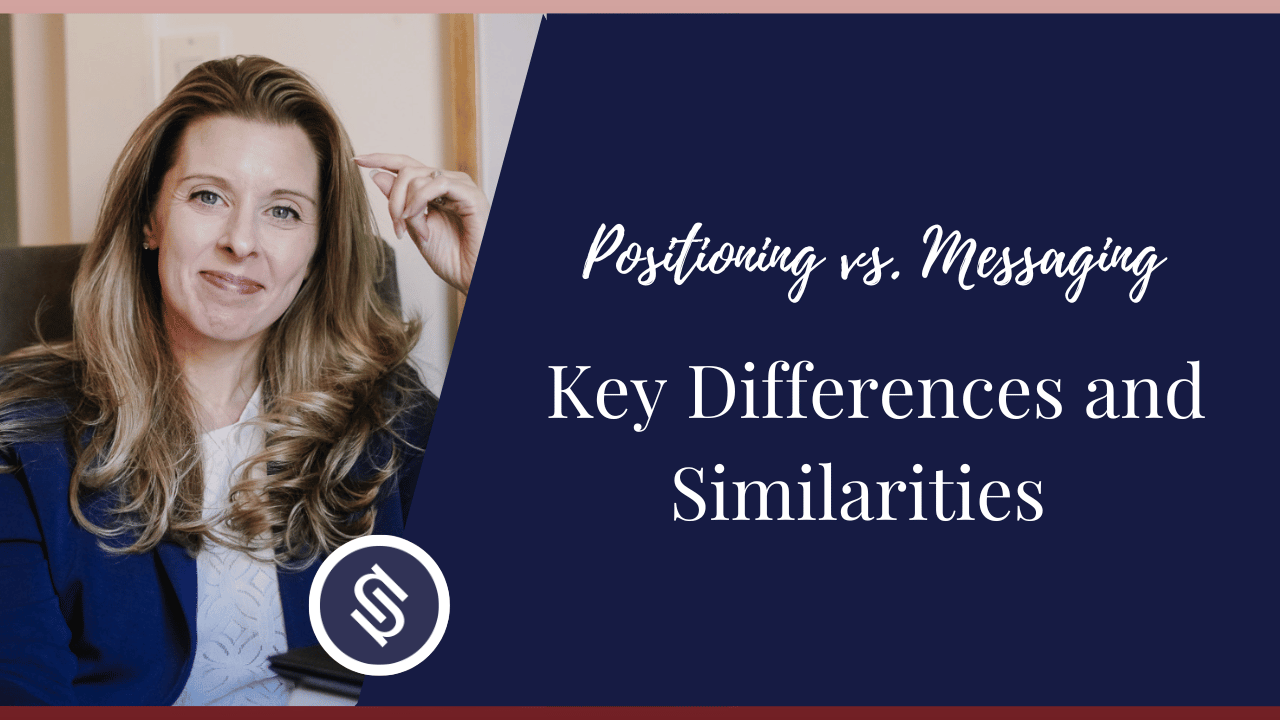Tuh-may-toe. Tuh-mah-toe. Two ways to say the same thing.
In marketing speak, positioning and messaging are often grouped together in the same pile of terminologies that mean “what brands communicate to their target audience.”
But unlike my “tomato” example, they’re two different things that function distinctly from each other and serve various purposes.
I’m Nora Sudduth, and we will talk about positioning vs. messaging in this article.
Need expert eyes on your marketing strategy? Let’s get started, and we will also cover how I can help.
TL;DR – Messaging vs. Positioning
If you’re in a hurry, skim through this overview to help you get started:
| Positioning | Messaging |
|---|---|
| A messaging exercise that clarifies your place in the market relative to your competition and answers the question, “Why you?”. | The way you express your positioning to your target audience. |
| A high-level, internal strategy that allows your team to understand your brand’s unique value proposition. | Has an external focus (your target audience) and guides how you create content and interact with your market. |
| Created to enable internal teams to communicate your brand to your audience accurately. | Ensures that key messages, content pieces, and interactions with your market are consistent with your brand position. |
| One overarching and concise statement that defines your brand and how it benefits your target audience. | Comes in the form of various statements that detail the benefits of your brand to specific audience segments. |
| Lays the foundation for effective messaging. | Results from clear positioning and allows for content that resonates with your target audience. |
Scratching your head over your marketing strategy? I can help you with that.
I’ve worked with numerous brands that have sold over $500M worth of products and services. Book a discovery call with me, and let’s design your next successful marketing campaign!
What is Positioning?
Positioning defines how you fit in the market and clarifies what sets you apart from your competitors. It’s a strategy meant to align internal teams on what your brand stands for and what you have to offer.
Any successful messaging strategy must begin by laying the proper groundwork. In branding, that’s your positioning statement. It ensures that you understand your brand so you can accurately articulate to your audience what makes you special.
Unlike messaging that adapts to trends and changes in the marketplace, positioning stays consistent and acts as the compass that ensures your messaging remains true to who you are as a brand.
What is a Positioning Statement Framework?
A positioning statement framework is a brief that defines key attributes of your brand.
Your framework should include the following details:
- Market position: How is your brand perceived in the marketplace? How do you want it to be perceived? If your market position doesn’t align with what you intend it to be, detail the steps you need to take to bring your brand where it needs to be.
- Buyer personas: These are representations of your target market. They help you better capture your audience’s attention and identify the needs, preferences, and interests that your brand meets.
- Unique value proposition: Your UVP outlines what differentiates you in the marketplace. It can be driven by cost (are you the most affordable option?), uniqueness in either product or service, quality, a new way to approach a solution or emotional appeal.
- Competition: You have to know who you’re up against. Include data about your competitors, like what market segments they’re succeeding with or opportunities they haven’t tapped into.

What is Messaging?
Now that the foundation is set, it’s time to roll up your sleeves and start working on your messaging.
Messaging expresses your positioning and results from clearly defining the benefits of your brand, products, or services. It entails a nuanced communication of those benefits to specific segments of your target audience.
Also, while positioning focuses on your team, messaging focuses on your audience. The target is external instead of internal.
What is a Product Messaging Framework?
A product messaging framework (or messaging hierarchy) is a structure that details how best to communicate your brand’s benefits to your buyer personas.
There is no one way to create a messaging framework, but you should find the following elements:
- Brand pillars: Give your brand a cohesive, recognizable identity that your audience resonates with.
- Target audience: How you shape your messaging depends on who it’s for. Defining your audience also helps create nuanced messaging targeting various audience segments.
- Objective: Explain what you intend to achieve with your messaging.
- Headline benefits: Present the key benefits of your brand or product in a concise and memorable way.
- Proof points: Provide evidence of how you deliver your headline benefits. These also bolster your brand’s credibility.
If you need help creating compelling and creative messaging for your product or brand, book a discovery call with me today!

Relevant Characteristics Between Positioning and Messaging
Let’s clarify positioning and messaging by looking at key characteristics defining the two.
| Positioning | Messaging | |
|---|---|---|
| Focus | Internal (your teams) | External (your target audience) |
| Objective | Aims to provide your teams with a clear understanding of your brand, its benefits, and your position in the marketplace | Aims to express the value of your brand to your target audience by translating your positioning into statements that resonate with each buyer's persona |
| Dependency | Depends on the strengths of your brand and the actual value of your offerings | Depends on the clarity of your positioning and the needs, interests, and preferences of each audience segment |
| Content Variation | Positioning statements or frameworks are concise and stay consistent over a period of time | Messaging statements can vary per audience segment and evolve over time |
| Application | Guides and informs your messaging | Used to inspire action and motivate engagement |
| Impact | Results in effective messaging | Results in higher engagement and conversions |
Similarities and Differences
Positioning and messaging often overlap as you construct your messaging architecture, so how do you know which is which?
Positioning and Messaging Differences
These are ways by which positioning and messaging differ from each other:
- Timing: Positioning is determined before any messaging can take shape, while messaging is created after clear positioning.
- Focus: Positioning is an internal exercise, while messaging has an external focus.
- Function: Positioning aligns internal teams on your brand’s story, while messaging speaks to your target audience about the value of your brand and influences their behavior.
- Content: Positioning is the context behind your story, while messaging is the content your audience consumes.
- Objective: Positioning aims to understand how best to communicate your brand value, while messaging is how you tell your target audience the benefits they gain by choosing your brand.
- Consistency: Positioning stays the same over time, while messaging evolves with industry shifts or to adapt to changes in your target audience.
Messaging and Positioning Similarities
Here are the ways these two concepts overlap:
- What they tell: Positioning and messaging both communicate your brand’s value.
- Marketing outcome: Both are necessary for your marketing strategy to resonate with your audience and drive results.
- Shaping brand identity: Both play a role in forming a solid and memorable brand identity.
As you build your branding, you’ll encounter these two terms frequently. Understanding how they work together is already half the battle!

What is a Value Proposition?
Value proposition is another marketing terminology often lumped together with positioning and messaging. But don’t confuse it to mean the same thing as either of the two.
Your value proposition is a statement of what your brand promises your market.
It’s the “what” of your brand:
- What you offer
- What benefits your brand delivers
- What its advantages are over its competitors
Essentially, your value proposition is the reason behind your positioning and the meat in your message.
Every marketing strategy begins with a clearly defined value proposition.

Bottom Line
Let’s recap this guide with these key takeaways:
Step one in your marketing is understanding your unique value proposition. Without it, you can’t define your positioning, and your messaging will lack punch.
While often confused as two ways to say the same thing, positioning, and messaging perform very different functions. Positioning allows you to align your teams on what your brand offers and what sets it apart in the market.
On the other hand, messaging is how you articulate your positioning or the value of your brand to your target audience.
All these–value proposition, positioning, and messaging–are necessary to build a strong and memorable brand.
Struggling to apply these concepts in your marketing strategy? Leave it to the pros.
Work with a brand strategist to build a strong brand, increase sales, and get more out of your marketing efforts.

Frequently Asked Questions (FAQs)
I’ve answered some of the most commonly asked questions about positioning and messaging below:
What Are the Key Components of Effective Messaging?
For your messaging to work, you need these three elements:
- Value proposition: Describe what you offer your potential customers, including the pain points your brand or product addresses and the solutions you provide.
- Understanding of your target audience: Shaping buyer personas through market and customer research will help you speak your audience’s language and resonate with them.
- Proof points: Social proof in the form of testimonials, case studies, and expert recommendations boosts your credibility and fosters trust.
Can You Change Your Brand’s Positioning Without Altering Its Messaging?
You can’t change your positioning without also reshaping your messaging.
Your messaging is the expression of your market position, which means that when your positioning changes, the messaging required to convey your brand story also evolves.
How Does Audience Perception Affect Positioning and Messaging?
Audience perception significantly impacts your market position, affecting how you communicate your brand value to your audience.
Let’s look at Zoom and Google Meet, for example. Zoom is primarily perceived as the video conferencing option for businesses, while Google Meet is seen as the more casual option for families and friends to connect.
That audience perception dictates their positioning (and if it doesn’t align with their desired position, they need to take steps to shift audience perception).
As a result, their positioning influences how they communicate their value, benefits, and features.
No wonder Zoom’s messaging focuses on business-related objectives, like enhancing productivity. Google Meet, on the other hand, is an easy way to communicate through video conferencing.
What Role Does Competitive Analysis Play in Positioning Your Brand?
Assessing your competition is crucial to determine what gaps in the marketplace you fill (or can fill, if you’re building a startup).
Also, analyzing your competitors will help you check how you fare against similar brands, compare what you do differently, and where others have succeeded (and how).
All of these insights will enable you to shape unique and memorable positioning–so you don’t just copy what other brands are doing!
How Can Small Businesses Leverage Positioning and Messaging for Growth?
Larger companies with deeper pockets can afford bigger marketing budgets, making them tough to beat. However, small companies can carve a share in the marketplace by leveraging a strong market positioning.
Positioning allows you to differentiate yourself from your competition, effectively leveling the playing field.
But doing that takes expertise. You need a pro who knows the ins and outs of all levels of marketing strategy. Work with a million-dollar marketing coach – schedule a discovery call with me today.
How Do Positioning and Messaging Work Together in a Marketing Campaign?
Positioning and messaging go hand-in-hand in marketing.
Positioning defines how your brand fits in the marketplace and elaborates on your brand value.
Conversely, messaging communicates your positioning to your target audience to influence their buying behavior in your favor.







